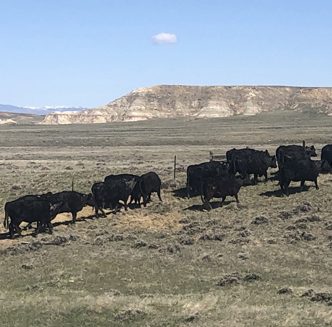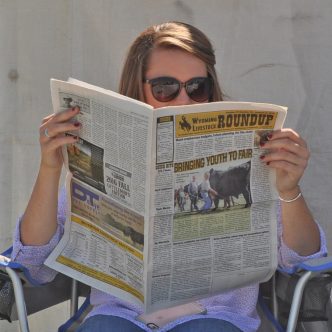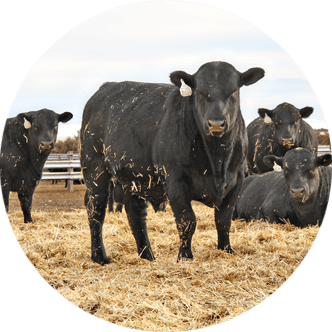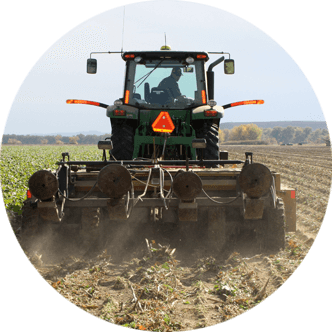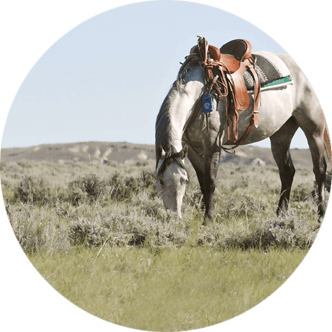Feeding production cows in confinement is an option for stretching grass during drought
For many producers, spring bloom comes with the anticipation of turning pairs out to green grass on pastures, rangelands and/or forest allotments for the summer. While feeding cattle in confinement through warmer months is generally the opposite of most cattlemen’s management strategies, University of Nebraska-Lincoln (UNL) Extension Cow/Calf and Stocker Management Specialist Dr. Karla Wilke says the practice may be useful for those battling persistent drought and poor pasture or rangeland conditions. Wilke discussed the ins and outs of feeding cow/calf pairs in confinement during a Jan. 13 webinar hosted by UNL.
Stretching
perennial pasture
The first reason producers may want to consider feeding their production cattle in confinement is to stretch perennial pasture, Wilke points out.
“For those in a drought situation, now is a good time to be thinking about what they are going to do come spring if things remain dry,” she begins, further noting there has been research conducted at UNL showing wet distillers’ grains mixed with either a really low-quality hay or crop residue can be used to replace grass intake at some level.
However, she admits it is difficult to achieve replacement at a one-to-one ratio.
“It’s extremely hard to get one pound of dry matter intake (DMI) from this mixture to replace one pound of DMI from grass,” she says. “Research shows only 0.22 pounds of DMI from grass is replaced, so for those trying to plan for pasture, I would use this conservative estimate and assume I’m only going to get the smaller ratio of replacement.”
“Regardless, it does stretch grass,” she adds.
For those who may not have the resources to feed their entire herd in a confinement setting, Wilke suggests only feeding cows and/or pairs selected for dispersal in order to save grass for the core herd.
“Another situation where producers may want to consider drylot feeding is those who are in a limited perennial acre situation,” Wilke says. “They may have access to products like wet distillers’ grains, beet pulp, sweet bran or something along those lines, and they can utilize this combination to increase productivity per acre.”
Meeting nutritional needs
“Regardless of why producers decide to do this, they have to ensure nutrient density of the diet meets their cattle’s needs,” Wilke states. “We can definitely be mindful and save on feed resources, but we have to make sure the cow’s needs are being met so she’s either maintaining or gaining weight, depending on where she’s at in the production cycle.”
Wilke notes a cow requires the lowest amount of nutrients between weaning and mid gestation. As she moves into late gestation and fetal growth begins, these needs begin to increase.
“When she has a calf and moves into early lactation, nutritional needs jump exponentially,” Wilke says.
“Remember, a cow has to rebreed about eight weeks or so after she has her calf and while she is in peak lactation,” she continues. “We really want to make sure she’s not losing weight during this period of time. But, the nice thing about confinement diets is they can be manipulated to make those things happen.”
Accounting for the
cow and calf
Wilke admits feeding pairs in this kind of a situation is far trickier than simply feeding gestating cows. Those who choose to feed cows and calves in confinement need to remember to meet the nutritional needs of both, Wilke notes.
“The thing that will trip producers up when feeding pairs is they don’t always remember to account for the fact a nursing calf still eats quite a bit of forage, and this increases as the calf grows,” she remarks. “Normally, calves are out on grass and it isn’t the producer’s responsibility to provide this forage, but in this situation, it will have to come in a bunk, in a line or on the ground.”
In the beginning of a calf’s life, the abomasum makes up nearly 60 percent of their entire digestive tract, as nutrients bypass the rumen and reticulum via the esophageal groove. At about three weeks of age, calves will start nibbling on grass, kickstarting development of the rumen.
“As the calf gets older, we want it to turn into a true ruminant animal with a properly-developed digestive tract,” Wilke says. “The rumen will go from 25 to 60 percent of the total tract, and the abomasum will go from 60 to 30 percent of the tract. Our goal before we wean them is for the rumen to make up 85 percent of the total tract.”
“We want this development to take place in a confinement setting just like it would out on pasture,” she adds.
However, in a drylot setting, Wilke admits it is hard to truly know if each cow and calf are getting the nutrients they need.
To better understand this, UNL researchers conducted a study over a two-year period looking at the difference between feeding pairs together and accounting for both the cow and calf’s needs versus offering calves their own custom creep feed.
“Calves that got the creep feed outgained those fed in pairs,” Wilke shares. “And, the creep-fed calves had a greater return over the cost of feed than the pairs.”
Wilke notes bagged and pelleted commercial creep feeds include a convenience tax and the potential to get a little spendy. Therefore, she encouraged producers to utilize resources they have available to create cheaper, custom diets.
Additionally, Wilke mentions producers need to allow at least two feet of bunk space per cow and one foot per calf.
Creating a drylot ration
Overall, rations used to feed cattle in confinement should include a poor-quality forage or residue mixed with nutrient-packed ingredients, Wilke says. This includes wet feeds like silage, wet distillers’ grains, beet pulp, sweet bran, wet corn gluten feed and/or molasses.
“These kind of ingredients make the feed more palatable for cattle, and we get better consumption,” she says. “The other thing that’s helpful is these kinds of wet feeds are pretty high in energy, and some of them are really good sources of protein as well.”
Similar to creating a custom creep feed, Wilke encourages producers to salvage products close to home to cheapen up the cost of creating a ration.
“We live in an area where we grow sugarbeets, so, at times, we have had access to actual sugarbeets before the sugar was taken out. They were selling them because they had started to rot and they needed to get rid of them,” she shares. “We took advantage of this and made a mixture of wheat straw and sugarbeets, which had the same total digestible nutrients as silage.”
Because this ration was lower in crude protein however, Wilke added a protein source and some poor-quality residue to create an efficient feed for her gestating cows.
“Some people live in areas with potatoes or cannery waste. There is always something, so be on the lookout for ingredients that might help cheapen up the ration,” she says.
For those in areas further from farm ground without access to a mixer or grinder, Wilke recommends buying bulk molasses; turning old, low-quality meadow hay bales on their side and soaking the bales with the molasses. This can be fed in addition to supplemental cake for gestating and lactating cows.
The last thing Wilke encourages producers to be mindful of is vitamin and mineral supplementation.
“When cattle are out on green grass, they get a lot of vitamins and minerals and they store it in their livers for later use. But when they are in a confinement situation or in areas which have continually been in a drought, cattle are probably not getting good vitamin and mineral content out of roughage or pasture,” she concludes.
Hannah Bugas is the managing editor of the Wyoming Livestock Roundup. Send comments on this article to roundup@wylr.net.

